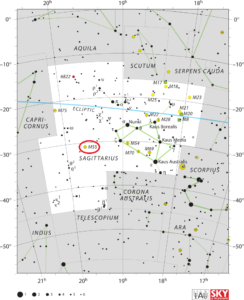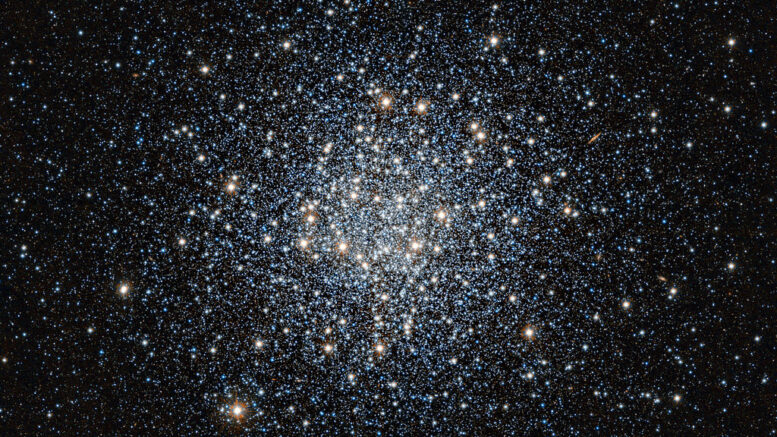Messier 55 (M55), also known as the Summer Rose Star, is a globular cluster located in the constellation Sagittarius. The stars in the cluster are mostly old and red, but M55 also contains an unusually high number of blue stragglers, old stars that appear younger, bluer and more luminous than similar stars their age as a result of interactions and mergers with neighboring stars in the cluster. It is one of the most metal-poor globular clusters known.
| Description | |
| Visible From Pacific Northwest | May To September |
| Best Time To Observe | June, July and August |
| Minimum Size Of Viewing Device | 50 mm binoculars |
| Object Type | Globular Cluster |
| Designations | Messier 55, M55, NGC 6809, Summer Rose Star, GCl 113, C 1936-310, MWSC 3150 |
| Right Ascension | Sagittarius |
| Declination | 19h 39m 59.71s |
| Constellation | -30°57’53.1” |
| Number Of Stars | 100,000 |
| Apparent magnitude | +7.42 |
| Apparent dimensions | 19′ |
| Object Radius | 48 light years |
| Distance From Earth | 17,600 light years |
History
The cluster was discovered by the French astronomer Nicolas Louis de Lacaille from South Africa on June 16, 1752. Lacaille catalogued the cluster as Lac I.14, noting that it “resembles an obscure nucleus of a big comet.”
Charles Messier was unable to find the object from Paris until July 24, 1778 because, being positioned under the Teapot in Sagittarius, the cluster never rose high enough in the southern sky to be an easy target. Messier had started looking for it as early as 1764.
William Herschel resolved the cluster into stars in 1783 using a 20-foot telescope. He wrote, “With 250 fairly resolved into stars; I can count a great many of them, while others are too close to be distinguished separately.”
John Herschel added the cluster to his catalogue as h 3798 and later included it in the General Catalogue as GC 4503. He described it as a “globular cluster; pretty bright; very large; round; very gradually little brighter toward the middle; diameter in RA 30.0s [7.5′]; all resolved into separate stars of 13 to 16 m; not so compressed toward the middle as to run together into a blaze or nipple.”
Locating M55 In The Sky
Messier 55 can be located by following an imaginary line drawn from Kaus Media, Delta Sagittarii, to Ascella, Zeta Sagittarii, and extending the line eastwards for about 17 degrees.

Viewing M55
It can be seen in 50 mm binoculars, but can only be resolved in medium-sized and larger telescopes. 8-inch telescopes will easily resolve many of the cluster’s stars.
The cluster has a low surface brightness and requires good observing conditions to be seen, even in binoculars.
With a density classification of XI, M55 is relatively diffuse and quite loose in appearance. It looks grainy even in smaller binoculars, unlike most globulars, which appear hazy and nebulous. The best time of year to observe M55 is in the months of June, July and August.
Photographing M55
Globular clusters are honestly low hanging fruit if you have a quality refractor. Short exposures are the best option for globular clusters for imaging as short exposures will not saturate the star cores and it is far easier to preserve the star colors both in the cluster itself and in the surrounding sky.
It is indeed possible to obtain a great photograph of Messier 55 using precision data capturing, even if using guiding. Thee have been some unguided photos of M55 that have been beautiful and can be found at the links below. Messier 55 might not require as much imaging, 70 minutes in some cases.
Sources And Further Reading
Descriptions of all of Messier Objects can be found here.
https://freestarcharts.com/messier-55

Be the first to comment on "Messier 55"